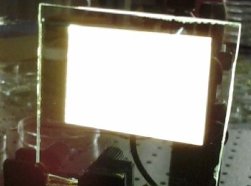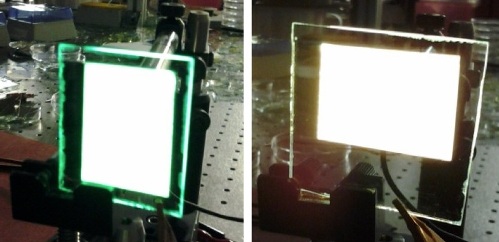Categories: Featured Articles » Interesting electrical news
Number of views: 14960
Comments on the article: 3
FIPEL Plastic Lamps - New Lighting Technologies
 Lighting accounts for a large share of energy consumption worldwide, for example, it is estimated that about 12 percent of total electricity consumption is accounted for by lighting. The reason is that traditional incandescent bulbs are very common today (Ilyich’s bulb with us, or edison bulb - in the USA) they eat a lot of energy, 90 percent of the energy is simply lost in them in the form of heat.
Lighting accounts for a large share of energy consumption worldwide, for example, it is estimated that about 12 percent of total electricity consumption is accounted for by lighting. The reason is that traditional incandescent bulbs are very common today (Ilyich’s bulb with us, or edison bulb - in the USA) they eat a lot of energy, 90 percent of the energy is simply lost in them in the form of heat.
The main alternative to this day was only compact fluorescent lamps and LEDswhich consume significantly less electricity can produce as much light as incandescent lamps. However, the fourth lighting option is approaching, and the technology called FIPEL is rightfully considered the first in the last 30 years, claiming the title of a new technology of energy-saving lighting. FIPEL from Field-induced polymer electroluminescent (field-induced polymer electroluminescence). A new light source was developed by a professor of physics from Forest Wake University (North Carolina), Dr. David Carroll.
To explain how this technology works, Dr. Carroll suggests recalling how a microwave oven works. Take potato for example. If you put it in the microwave and turn on the heating, the device will act on the potato with microwaves, causing bias currents, causing water molecules inside the potato to move back and forth, and the product will be heated from the inside.
Dr. Carroll and his team have developed a special type of plastic that, when interacting with electric current, induces a bias current in this way. But in the latter case, there is no heating of the plastic, but the emission of light.

The new light source is made of several layers of very, very thin plastic, each layer being 100,000 times thinner than a human hair. Plastic is placed between two electrodes, one of which is aluminum, and the other is transparent and also conductive. When current flows through the device, the plastic is stimulated and glows.
The basis of the technology is doped with single-walled nanotubes and iridium compounds, the polymer is polyvinylcarbazole. The brightness achieved by the researchers exceeds 18,000 cd / sq.m, which already allows you to illuminate large areas without resorting to very hot transitions of LEDs; in FIPEL technology there is no such strong heating as other lighting solutions.
Fortunately for David Carroll, FIPEL appeared on time, because now is just such a period when new technologies in lighting are more in demand than ever, since the production of traditional incandescent lamps is being scaled up rapidly.
Manufacturers claim that FIPEL technology has no analogues. For example, compact fluorescent lamps use 75 percent less energy for lighting than incandescent lamps, and LEDs are even less. This means that CFL gives as much light as a 100-watt incandescent lamp, consuming 23 watts, and light-emitting diode (LED) - 20 watts. FIPEL, in turn, is somewhat more efficient than compact fluorescent lamps, and LEDs are equal in efficiency, however, they have a number of advantages.
CFLs contain mercury, which is toxic and requires proper disposal. There will be no toxic or any other caustic chemicals in future FIPEL technology bulbs, as this is just plastic and can be disposed of like plastic.
LEDs often have a bluish tint, which many do not like, and color rendering LEDs are not always the best. FIPEL can have any shade, including the yellowish shade of the sun, to which our eyes are accustomed in the process of evolution, which is most comfortable for us.
Although the new light source does not have the shape of a traditional light bulb, it looks more like a large panel in shape, nevertheless, the shape can be changed, and then the lamp will easily fit into any interior, being installed in a standard cartridge. The life of FIPEL is also comparable to LEDs - from 25,000 to 50,000 hours.
However, there were some shortcomings. Dr. Carroll notes that the efficiency of FIPEL technology is still slightly less than what can be achieved using LEDs, and LEDs are practically the best light sources at the moment. Despite this, Dr. Carroll hopes to see his brainchild on the market by 2020.
See also at bgv.electricianexp.com
:

